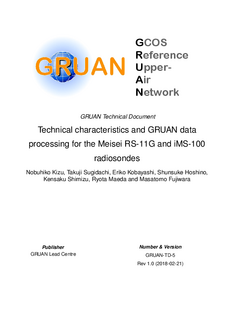Technical characteristics and GRUAN data processing for the Meisei RS-11G and iMS-100 radiosondes
GRUAN-TD-5
Details
- ID
GRUAN-TD-5
- Title
Technical characteristics and GRUAN data processing for the Meisei RS-11G and iMS-100 radiosondes
- Authors
Nobuhiko Kizu, Takuji Sugidachi, Eriko Kobayashi, Shunsuke Hoshino, Kensaku Shimizu, Ryota Maeda and Masatomo Fujiwara
- Last version
v1.0 (2018-02-21)
- Status
Published
- Download
Abstract
The GCOS (Global Climate Observing System) Reference Upper-Air Network (GRUAN) data processing for the Meisei RS-11G and iMS-100 radiosondes has been developed to meet the criteria for reference measurements. Since July 2013, the RS-11G radiosonde has been regularly launched at Tateno (36.06°N, 140.13°E, 25.2 m; Aerological Observatory of the Japan Meteorological Agency), Japan. Also, a smaller version, the Meisei iMS-100 radiosonde has been developed, with the same sensors as those of the RS-11G radiosonde, and will be used at Tateno in the future. This technical document describes the algorithms including the corrections to obtain pressure (or geopotential height), temperature, relative humidity (RH), and horizontal wind data from the RS-11G and iMS-100 radiosonde raw data. It also discusses the uncertainty evaluation for each variable obtained from these radiosondes. The corrections compensate various known systematic biases, which are mainly the solar radiation error, calibration error, and heat spike error for the temperature measurements, and the dry biases due to solar heating, time-lag error, and calibration error at low temperature conditions for the RH measurements. The measurement uncertainty for each variable was evaluated by laboratory experiments and verified by comparison flights. The uncertainty for the temperature measurements is mainly determined by that of the corrections for the solar radiation error and calibration error. Its uncertainty increases with altitude, and reaches 0.8K at 30 km. Up to ∼15 km, the calibration-error correction is the dominant factor to the total uncertainty of the temperature measurements, while in the stratosphere, the radiation correction is the dominant factor. Because the actual sounding conditions are different from the assumed condition (e.g., surface and cloud albedo), it is considered that additional information for each sounding, such as the cloud condition, is necessary to reduce the uncertainty. Also, the uncertainty due to heat spikes needs to be considered for particular flight configurations (e.g., the case with a shorter string of 15m and a 600 g balloon). A large payload and a rig for multiple-payload sounding may introduce additional heat spikes and thus larger uncertainty. The uncertainty of the RH measurements is maximal around the tropopause because of the large and sudden change in RH between the wet troposphere and dry stratosphere and of the coldness there, leading to large time-lag correction component. The uncertainty from the calibration-error correction is relatively large at low temperatures because the evaluation is difficult there. Solar heating on the RH sensor leads to dry bias; thus, this bias is corrected by considering the difference between the sensor temperature and air temperature. The uncertainty from the solar heating dry bias correction is derived from the sensor temperature measurement uncertainty (±0.3 K). The sensor temperature is measured with the dedicated thermistor for the iMS-100, and is estimated by the solar radiation correction and thermal-lag for the RS-11G. There are other minor factors contributing to the total RH uncertainty, though they are currently not quantified. The hysteresis bias arises only when the RH changes from wet to dry. The contamination error causes wet biases only under rainy conditions, though its quantification is currently not possible because the RH reference measurements do not exist under rainy conditions. The uncertainty for the geopotential height is determined by the accuracy of the Global Positioning System (GPS) antenna and module in use (as the RS-11G and iMS-100 radiosondes are usually not equipped with a pressure sensor). The 3 dimensional error of the GPS for the RS-11G and iMS-100 is typically less than 10 m. The pressure is calculated from the GPS geopotential height using the relationship of the hydrostatic equation and thus using temperature and RH data. Therefore, the uncertainties in the GPS-based geopotential-height, temperature, and RH measurements propagate to the uncertainty of the pressure measurement. In addition, the uncertainty of surface pressure measurement affects the total pressure uncertainty. The geopotential-height uncertainty is the main factor for the pressure uncertainty at lower altitudes, while the temperature uncertainty is the main factor at higher altitudes. Also, the uncertainty of the surface pressure measurement contributes to the pressure uncertainty at all levels. The uncertainty (1σ) of the GPS Doppler speed measurements is less than 0.01ms−1, and thus this is not the main factor of the uncertainty for the GPS-based horizontal wind measurements. The main factor comes from the radiosonde pendulum motions during the flight. Such oscillations are removed by a software filter (in particular for operational sounding data). Because of this filtering, smaller-scale variabilities with the periods less than the pendulum period cannot be obtained. The period of the pendulum motion is 7.8 s for the string of 15m length, and the uncertainty due to these oscillations are typically 1 – 3ms−1, being larger at higher altitudes.
History
- v1.0 (2018-02-21)
Nobuhiko Kizu et al., Technical characteristics and GRUAN data processing for the Meisei RS-11G and iMS-100 radiosondes, GRUAN-TD-5, v1.0 (2018-02-21).
